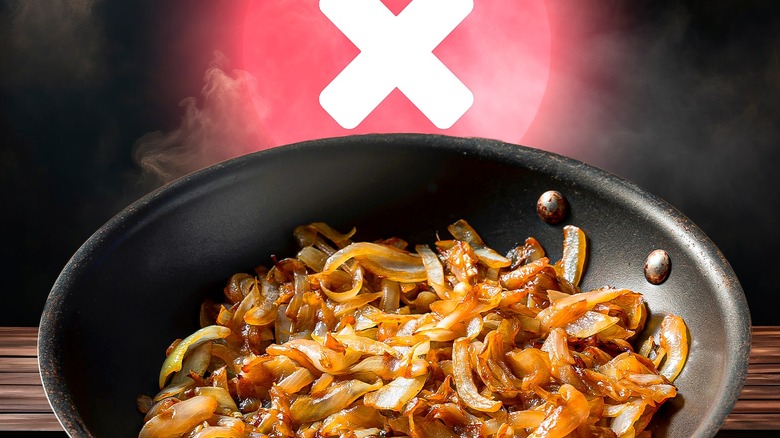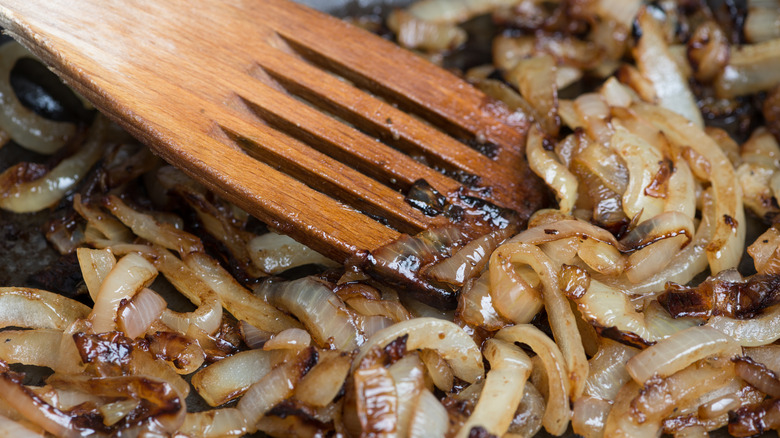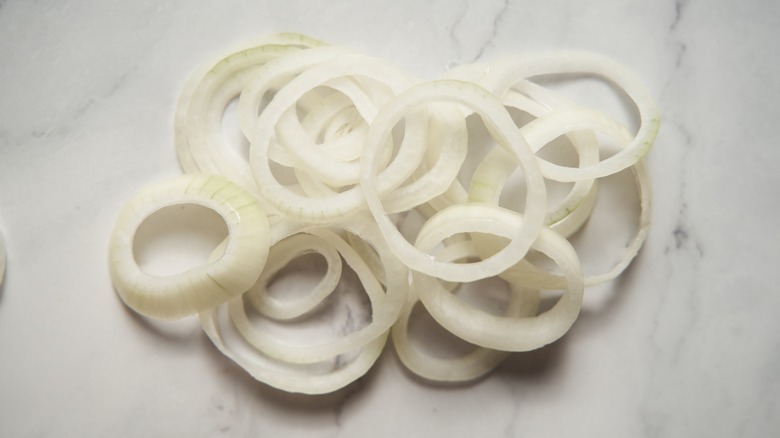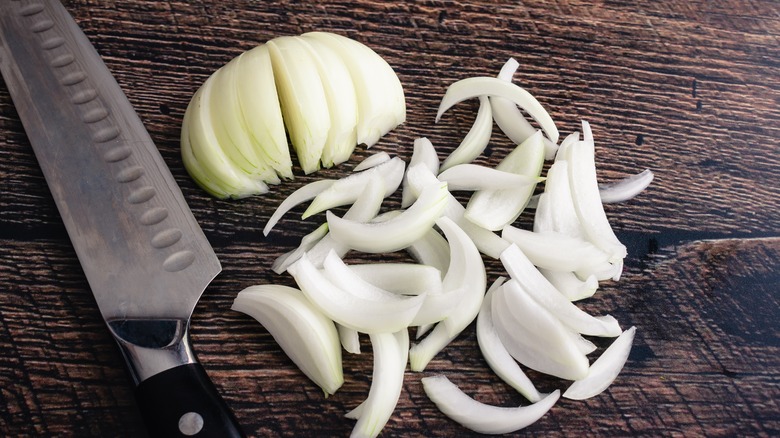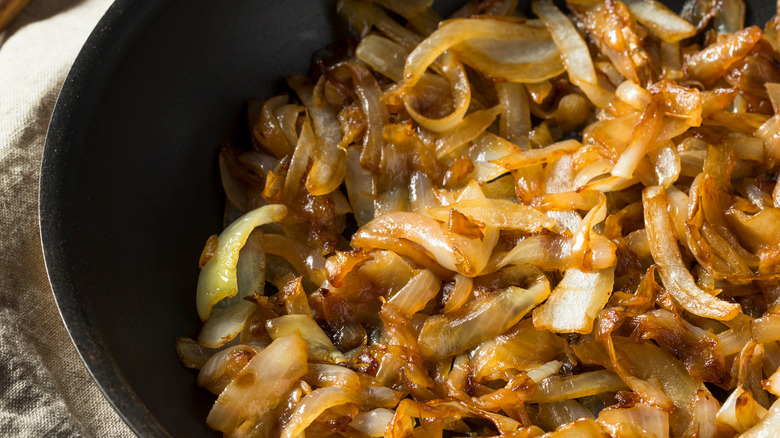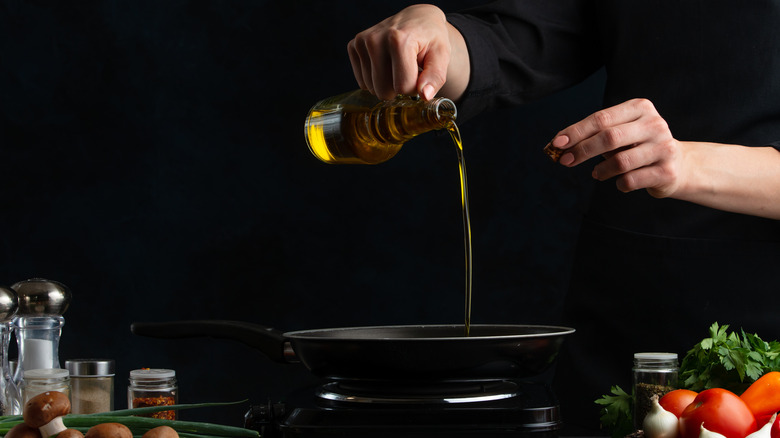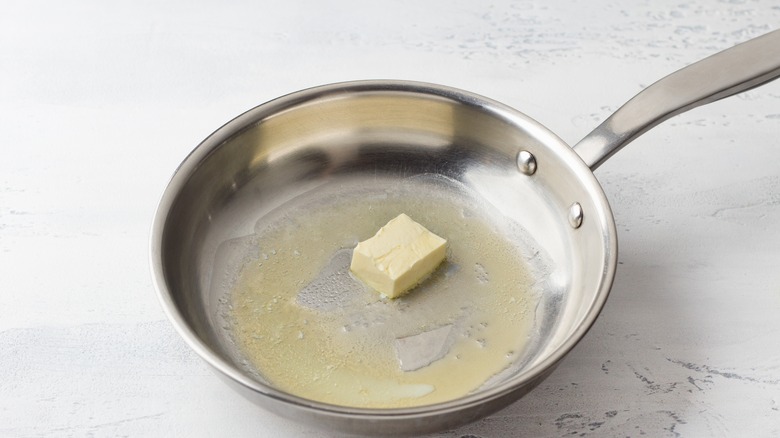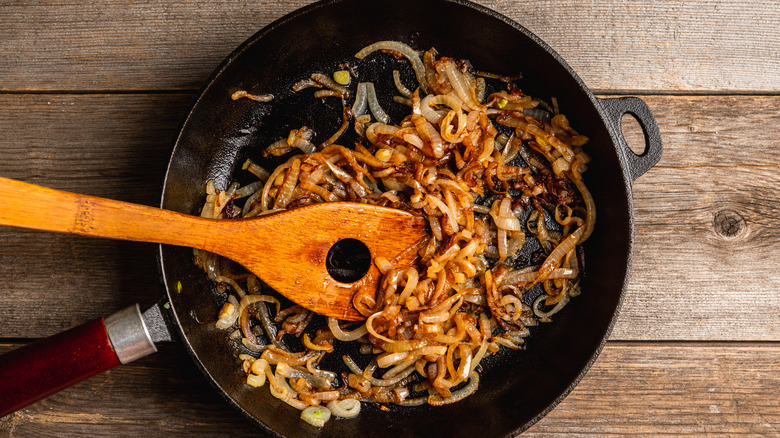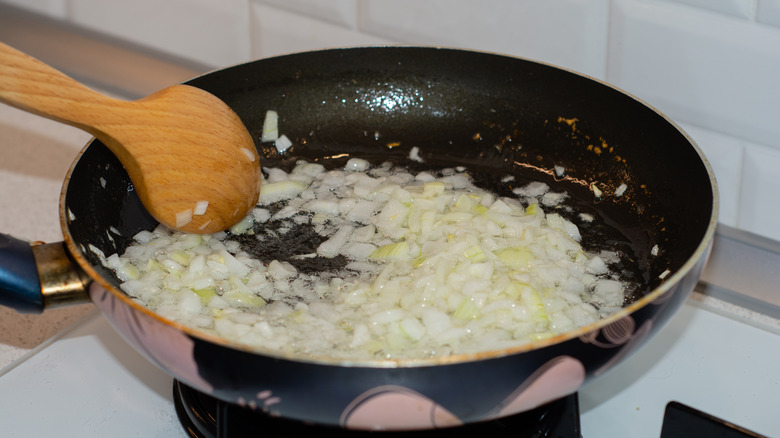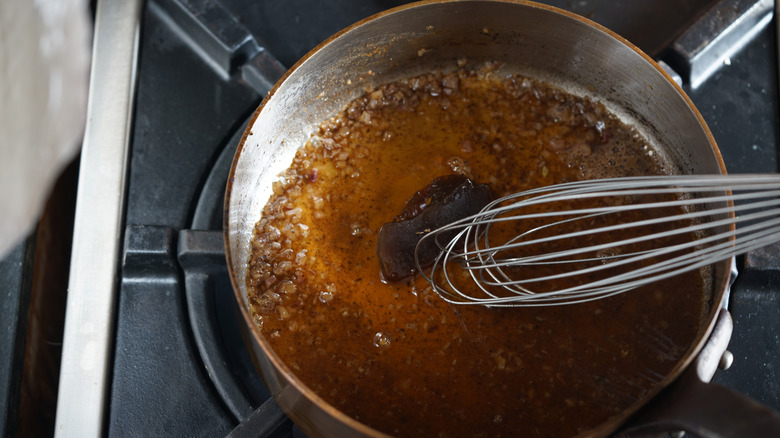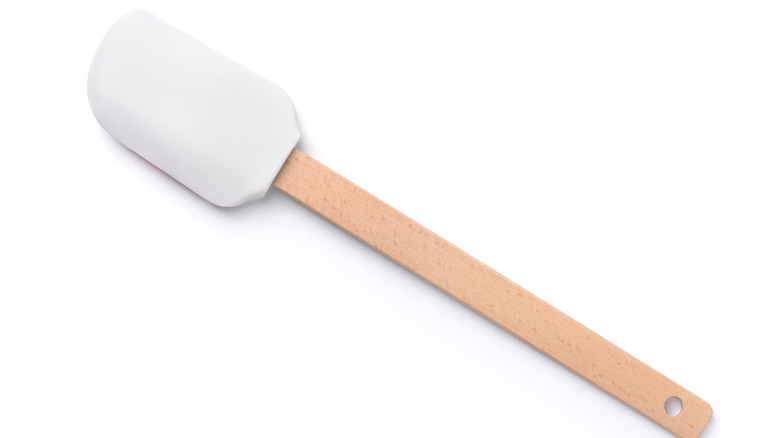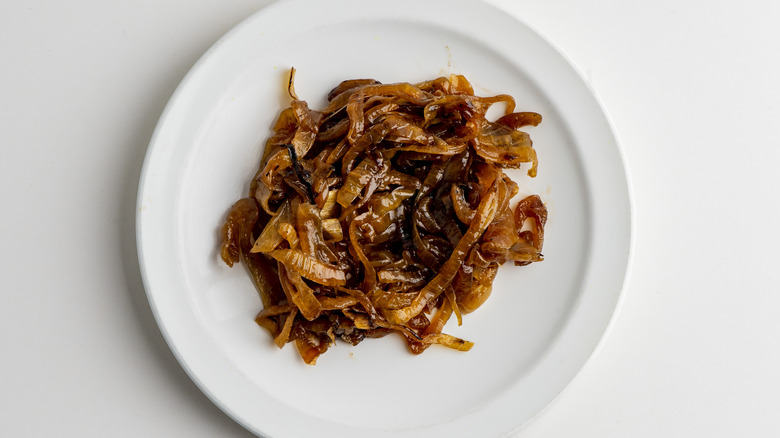13 Mistakes Everyone Makes When Caramelizing Onions
There's nothing like perfectly caramelized onions. They're jammy with a subtle smokiness and complex sweetness and can go on just about anything savory. They make the perfect condiment for adding to sandwiches, pizza, steak, hamburgers, tarts, omelets, dips, grilled cheese, and more. They're also the key process behind creating the beloved French onion soup. That deep layer of onion flavor comes from the caramelization process. Caramelized onions are a labor of love, but they're quite tricky to make. Most people who try to make them for the first time think they just need to turn up the heat and then add a bunch of sugar, resulting in a burnt, bitter mess that's hard to eat.
They take some time to get right, but once you understand how to proceed, you can make perfectly sweet and umami, soft but not mushy, caramelized onions. There's a technique behind drawing out the water and natural sugars from the onion, making sure not to let them burn, dry out, or totally disintegrate. There are so many ways that you can go wrong, and you need to have a lot of time and the commitment to stand by them as they cook. Before I went to culinary school, I made all the mistakes in the book. Now, I've had years of training and experience in making them the right way. Here are some of the common mistakes that everyone makes when caramelizing onions and how to avoid them.
1. Being impatient
It's normal for people to try to find shortcuts when cooking, but sadly, for lovers of caramelized onions, there are none. People often try to add balsamic vinegar, baking soda, or extra sugar to get onions to caramelize faster, but none of that works. As seductive as it might sound, any recipe that promises you beautiful caramelized onions in minutes is deceiving you. You might get browned onions, charred onions, or something more like a sautéed onion relish. However, it's a different result when you transform an onion from a firm, sharp, raw allium to the tender, amber-colored magic that is caramelized onions.
Onions take a lot of time to break down to the point that the natural sugars can start to cook. Top top tip you need for caramelized onions is simply patience. You can't shorten the time it takes to get them cooked down, jammy and dark brown, by turning up the heat because they'll burn before they caramelize. Generally, it can take between 30 minutes to an hour, if not longer.
2. Slicing onion slices too thin
Another way that people try to take a shortcut is by cutting onions into smaller pieces. It makes sense with most foods; smaller pieces will have more surface area exposed to heat, so they will cook quicker. That's a way to cut down cooking time on something that also takes ages to cook, like potatoes. Cutting potatoes into smaller pieces, whether you're boiling or roasting them, decreases the cooking time. Onions are a whole different ballgame. The reason you shouldn't slice onions too thin when caramelizing is that they'll be even more prone to burning.
The onions will indeed heat faster when cut really thinly, but they'll end up heating too fast for true caramelization to occur. Onions need to cook for a long time for the natural sugars to come out and for that delicate flavor to develop. If they heat up too quickly, they'll burn before that can happen. Yes, there are no shortcuts, but it's also really difficult to slice onions too thin, so at least you don't have to go through that tricky step.
3. Cutting against the grain instead of with the grain
For the best caramelized onions, how you cut your onion matters. Too thin and they'll burn; too thick and they'll take even longer than usual to caramelize. If you cut them unevenly, some slices might burn before others cook, or some might undercook and not develop the right texture and taste, making your batch inconsistent. If you're going to go through the effort of caramelizing onions, you should take the step of slicing your onions seriously. Even slices will cook at the same speed and give you a better chance of succeeding.
The beauty of onions is that you don't need a special kitchen gadget to help you cut them evenly. Nature has provided the lines along which you need to slice. The lines running across an onion from the root to the stem are called the grain. Not only is it helpful for the size and consistency of the slice to cut with the grain of the onion, but it will also aid in better caramelization. When you cut against the grain of an onion, it's more likely that your onions will disintegrate and turn mushy. Keeping with the grain will help the slices retain their shape by not releasing excess water, making for an evenly textured batch of caramelized onions with a pleasant bite.
4. Over-relying on sugar
Some people think that caramelized onions are sweet because of added sugar. You might incorrectly add sugar to sauteed onions, thinking that's how one makes caramelized onions or speeds up the process. Instead, you'll make something resembling a caramel with onions, but it's a far cry from the delicate flavor and texture of correctly made caramelized onions.
In truth, you can make caramelized onions with zero added sugar. Surprisingly, onions contain natural sugars, and cooking them low and slow helps release them. These sugars are responsible for the caramelization that occurs, and that's why it's important to take time to let your onions cook for long enough to achieve this. You may add a little sugar if you prefer extra sweetness, but it's better to add them near the end of cooking so that the sugars don't burn before your onions have had a chance to caramelize naturally. However, if you taste your onions and they're not sweet enough, it's likely that they're not done yet and need more time to cook.
5. Being stingy with the oil or butter
Another mistake that people make when caramelizing onions is by adding too little fat. Many don't want their caramelized onions greasy or oily, so they add less oil than needed. While the onions will release water and cook in their own juices, it's important to add at least enough oil to coat the entire surface area of your pan. This will prevent the onions from getting stuck onto your pan, which can lead them to burn rapidly.
Too little oil isn't good, but adding too much can also be a problem. Thinking that the only way to prevent burning your onions is by adding a lot of oil will not work. The onions will end up frying or steaming in the oil or butter rather than cooking slowly enough to release their natural sugars. You need just enough oil to coat the pan and keep it lubricated. You'll need to use your senses here. If you see the onions looking really dry and sticking too easily to the pan, that's when you should add in a little bit more oil.
6. Cooking with butter only
Many caramelized onion recipes call for using butter, which adds a little richness to the flavor and makes them taste amazing. However, you can't use butter alone as the sole fat in the recipe, so be suspicious if you see a recipe that tells you to only use butter. The reason you shouldn't only use butter to caramelize onions is because they're more likely to get you burnt onions rather than caramelized. Butter has a low smoking point and will end up getting too hot too quickly when you need enough time to properly caramelize your onions. Your onions may look nicely browned quicker, but that's only on the outside. Inside they'll still be white and undercooked, and they'll taste bitter rather than sweet.
Using oil will help you avoid this, giving you enough time to let the onions cook and break down in the required time. However, if you love the idea of buttery caramelized onions, you can use a combination of butter and oil, because the oil will insulate the butter and prevent it from burning.
7. Using the wrong pan
One of the best ways to ensure even cooking for your onions is to use the right type of pot or pan. The first thing to look out for is that your pan is non-stick. This will help you to prevent your onions from getting stuck to your pan and burning. While a little bit of onions getting stuck will create a subtle char flavor, if you don't use a non-stick pan, your onions will likely stick a lot more than is acceptable and make the caramelizing process much more difficult than it needs to be. A non-stick pan will help you stir them with ease as they cook down.
The size of your pot or pan also makes a difference. A bigger pot is Ina Garten's pro tip for caramelized onions. If your pot is too small, the onions will overcrowd and make it difficult for them to evenly caramelize, as the onions on the bottom will cook quicker than the top. They'll also release water too quickly and end up steaming, making the process take much longer than necessary.
8. Underestimating the amount of onions to cook
The process of making caramelized onions can be a little tedious, so it's always a good idea to make it worth it and make a big batch. There's nothing more disappointing than putting your heart and soul into perfecting a pot of caramelized onions, only to end up with about half a cup's worth at the end. If you've ever cooked up a big bag of spinach, you'll understand the running joke about how little you'll have in the end. It's almost shocking how much they decrease in size when cooked. To be fair, onions do not shrink as drastically as spinach, but they will decrease in size as they cook. As they're mostly made of water, more than half of that volume will disappear.
Always prepare a little more onion than you think. To a degree, of course, because you don't want to completely overcrowd your pan. However, if you think two or three onions will do, that's probably too little. As a general rule of thumb, you can make about two cups of caramelized onion using five large onions. Plus, you can always freeze some if you don't end up gobbling them up quickly enough.
9. Stirring too often or not enough
Everyone loves slow-cooked foods because of how little you actually have to do. To make a silky soft beef stew, you can leave it on the stove on its own for hours to let the magic happen. Sadly, onions aren't as independent. When making caramelized onions, it's so tempting to leave them unattended completely. Still, you can do a bit of multitasking because onions do need a lot of time to cook down, but the bottom layer will cook quicker than the rest if left unstirred. This can end up burning or overcooking them. The reason it's important to stir onions when caramelizing is to keep all your onions cooking evenly.
Keep in mind that there's also a risk of stirring too often. If you're nervously stirring the onions too much, you won't let them cook enough to undergo the Maillard reaction. This is the scientific name behind the "browning" that creates the complex umami flavor that everyone loves. If you're unsure about how often to stir, it's a good idea to stir every ten minutes.
10. Having your heat up too high
Another way that people try to quicken the process is to crank up the heat. This is a sure way to end up with burnt onions. Even if you stir your onions often, heat that's too high will quickly brown the outside of your onions without properly caramelizing them. It may take a lot of patience to watch your onions go through the color changes at a slow pace, but this is the best way to achieve the delicious result you're looking for. On the contrary, if you have your heat down too low, you'll be standing over your onions forever. This makes it difficult to know just how much heat to apply.
How high your heat should be for perfect caramelized onions is all about the balance between having enough heat to cook your onions all the way through but slowly enough to properly create natural caramelization. A medium heat can hit the sweet pot, but if your onions are starting to brown or burn on the outside, turn the heat down slightly. And if you're feeling nervous, low heat is the safest bet.
11. Not deglazing the pan
After giving onions enough time to caramelize and taking care to get everything else right, cutting them evenly, and monitoring them throughout, you might still be lacking the desired complexity of flavor if you forget to deglaze the plan. Often, the bottom layer of your pot or pan is where any sticky bits of onions can be forgotten, but these slightly charred pieces are essential to add more umami and depth to caramelized onions. This is why you should always deglaze your pan when caramelizing onions.
Deglazing your pan is a fancy way of saying add a liquid to your pan and using a spoon or spatula to pick up any bits of food clinging to the bottom. Deglazing also adds even more flavor because your liquid can be things like vinegar, wine, beer, or chicken broth. All of these options are great for caramelized onions and will add another dimension to them.
12. Using the wrong tool to stir
Stirring is such a crucial part of the process when making caramelized onions that what you use to stir can make a big difference. Stirring allows you to keep the onions moving in order to achieve even caramelization and prevent burning. You also want to be able to pick up all the pieces of flavorful browned bits when you deglaze your pan. So, although you can use a plastic spatula or a wooden spoon to stir your onions, a silicone spatula is the best tool for stirring caramelized onions.
A silicone spatula will help you effortlessly scrape the bottom of your pan without scratching or damaging it. It's also really easy to use and won't leave any onion pieces stuck to the bottom. This will help you prevent your onions from burning, which is so important to making perfect caramelized onions. Even as you've carefully watched your pan, the onions can still burn at the last minute, just before they're ready, making all of your effort a waste. That's why choosing the right tool to keep things moving will keep you from disappointment throughout cooking.
13. Only cooking on a stove-top
By now, it's been drilled in that there aren't any shortcuts to making true caramelized onions, but if you're still looking for a trick to help make the process easier in any way, there is the option of forgoing the stove top altogether. This isn't necessarily a major hack, but you can save time by cooking large batches of caramelized onions in the oven.
You'll still have to stir occasionally, but it will be less intensive than standing over the stove and stirring every ten minutes. Make sure to take all the other important steps, like cutting your onions into even slices that aren't too thick or too thin (remember to cut along the grain and not against). Then, lay them out in an even layer on a baking sheet with a splash of olive oil. Place them in at around 400 F for about an hour, checking them a few times to stir them and make sure they don't burn.
